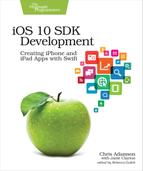Counting with Numeric Types
Let’s play with some more math. We’ll create another variable:
| | var bar = 0 |
That looks good, and since it’s a variable, we can change its value:
| | bar = 0.5 |
Oh, no! We get another error, and this time without an instant fix. Worse yet, the description is unhelpful: “Cannot assign a value of type ’Double’ to a value of type ’Int’.”
So what’s the deal? Can Swift seriously not convert between floating-point numbers and integers? Actually, Swift can, but our variable bar cannot. The problem is that we never specified what the type of bar is, so the Swift compiler made its best guess. And it guessed wrong. In fact, the instant fix proposes to replace 0.5 with Int(0.5); that will make an integer by rounding down 0.5 to the nearest Int, which is 0—not what we want! Instead, replace the bar = 0.5 line with the following:
| | type(of: bar) |
The type(of:) function allows us to see what type a value has. In the right pane, we see that the type evaluates to Int.Type. That makes sense: since the original value was 0, Swift took a guess and assumed we wanted an integer, not a floating-point type. This inferring of types is called, appropriately, type inference.
We could tell Swift to use a floating-point type by using 0.0 as the initial value; try that and you’ll see the inferred type becomes Double.Type. But if we want a given type, we should just declare it that way. Change the declaration like this:
| | var bar : Double = 0 |
Now Swift doesn’t need to infer anything: we’ve explicitly declared that we want bar to be a Double, meaning a double-precision floating-point type.
There’s also a lower-precision floating-point type, Float, and a Boolean type, Bool. In some languages, such as C, you can cast between integers, floats, doubles, and Bools, and the worst that will happen is that the compiler will warn you about loss of precision. Swift forbids this altogether, even if you wouldn’t be losing anything. Try this:
| | let myInt = 1 |
| | let myDouble : Double = myInt |
This leads to an error saying “Cannot convert value of type ’Int’ to specified type ’Double’.” We can’t just cast between types like in many other languages; to create myDouble, we need to tell Swift to create a new Double:
| | let myInt = 1 |
| | let myDouble = Double(myInt) |
The second line here uses Double’s initializer to create a new Double, using the value passed in as a parameter.
Swift’s numeric types work with many of the usual arithmetic operators popular in other languages: +, -, *, and /. The remainder operator, %, is available for the Int type, while Float and Double types need to use a related method, truncatingRemainder.
On the other hand, thanks to strong typing, Bools aren’t just numeric values, and thus none of these mathematic operators works with Boolean values. And that’s a good thing, because what would “false divided by true” mean, anyway? Instead, we use the usual Boolean operators ! (NOT), && (logical AND), and || (logical OR).
